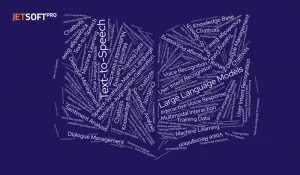Conversational AI holds a special place in customer service among the many functional subtypes of AI solutions. Today, a solution like an AI call center or chatbot can, if not completely replace human support services, handle at least 80% of inquiries without human involvement.
Interestingly, despite the steady growth of people preferring text communication over calls, the demand for phone calls remains high — sometimes clients simply want to talk to someone from the business. In this blog post, we explore the current capabilities of AI call centers and the risks associated with this method of business optimization.
What is an AI Call Center?
An AI call center is a solution that uses artificial intelligence technologies to handle calls and interact with customers. This is a popular cost-optimization method for businesses that work with a large number of clients. For example, companies in FMCG, restaurants, online stores, travel agency websites, cleaning companies, and other large businesses that clients often call.

An AI call center can perform various functions, including:
1. Call Sorting
An AI call center can automatically answer incoming calls, classify them, direct them to the appropriate operators, or provide the necessary information to customers. For instance, a voice assistant can distinguish between a restaurant customer wanting to place an order and one willing to reserve a table and either redirect such calls to an operator or even generate the order in the system or record the reservation in the calendar.
2. Resolving Customer Issues
You can train a voice assistant to respond to the most frequent and even specific inquiries based on the company’s processes. If you often receive calls to clarify delivery details, the voice assistant can provide the required information to the calling customer, identifying the specific piece of data being requested.
3. Data Analysis
An AI call center can analyze conversations and collect data about customers, identifying trends and potential problems. For example, voice assistants can record the number of defect-related inquiries for different types of products and send you statistics to help you decide which suppliers to stop collaborating with.
4. Training
These systems can use machine learning to improve service quality by learning from interactions with customers. For example, a voice assistant can record all inquiries it failed to answer, send them to a human operator, and request the correct response, which will be recorded in its system, so next time it will manage by itself.
5. Supporting Operators
AI can provide operators with conversation recommendations and help with more complex inquiries. For instance, if a customer has already spoken to a virtual assistant and is now redirected to a human operator, the voice assistant can summarize all important information into a list of 3-4 facts for the human operator to quickly familiarize themselves with the case.
Read also: Creating an affordable virtual assistant for your website
Terminology and Concepts You Need to Learn Before Starting Work with an AI Call Center
Large Language Models (LLMs)
Large language models (LLMs) are machine learning models that can understand and create human language text. They do this by analyzing huge datasets of language. Using LLMs in AI call center solutions makes the responses of your voice assistant sound more human-like. An important part of this is the correct emotional tone of the voice response. This can be achieved with Sentiment Analysis, a relatively new technology, and Text-to-Speech (TTS).
Text-to-Speech (TTS)
TTS systems are trained to create speech with varied intonation, making voice assistants sound more natural. Modern TTS systems like Tacotron 2 and WaveGlow can synthesize speech with different intonations, speeds, and emotions.
Retrieval-Augmented Generation (RAG)
Retrieval-augmented generation (RAG) improves the output of a large language model by referencing an external authoritative knowledge base before generating a response. Large Language Models (LLMs) are trained on massive amounts of data and use billions of parameters to generate outputs for tasks like answering questions, translating languages, and completing sentences. RAG enhances the powerful abilities of LLMs by applying them to specific domains or an organization’s internal knowledge base without needing to retrain the model. This method is cost-effective and ensures the LLM output is relevant, accurate, and useful in various contexts.
Interactive Voice Response (IVR)
Interactive Voice Response (IVR) is an automated phone system technology that lets incoming callers access information via a voice response system of pre-recorded messages without needing to speak to an agent. Callers can use menu options through touch-tone keypad selection or speech recognition to route their calls to specific departments or specialists.
IVR Containment Rate
When working with an AI call center, your main efficiency metric is the IVR containment rate. This metric shows the number of incoming calls handled without a human operator. In simple terms, it’s the percentage of calls fully processed by the automated IVR system out of the total incoming calls. An 80% containment rate is considered a good performance in modern IVR solutions.

Additional Terminology and Concepts
- Machine Learning (ML): A subset of artificial intelligence where computers use data to learn and make decisions without being explicitly programmed for each task.
- Natural Language Processing (NLP): A field of AI focused on the interaction between computers and humans through natural language. This includes understanding, interpreting, and generating human language.
- Sentiment Analysis: A process in NLP that identifies and categorizes opinions expressed in text to determine the writer’s attitude as positive, negative, or neutral.
- Chatbots: AI programs that simulate human conversation. They can be text-based or voice-based and are often used in customer service to handle common queries.
- Voice Recognition: Technology that can identify and process human speech, converting it to text or understanding it to perform tasks.
- Training Data: The dataset used to train a machine learning model. It helps the model understand patterns and make predictions. Talking about the AI call center, we mean, first of all, your scripts and FAQ.
- Knowledge Base: A collection of information that a machine learning model can reference to improve the accuracy and relevance of its responses.
- Speech Synthesis Markup Language (SSML): A standard for specifying the way text is spoken in text-to-speech systems, allowing for the inclusion of details such as pauses, intonation, and emphasis.
- Dialogue Management: The process of managing a conversation flow in AI systems to ensure coherent and contextually appropriate interactions.
- User Intent Recognition: The ability of an AI system to understand and identify the user’s goal or purpose behind their input, is crucial for accurate and helpful responses.
- Multimodal Interaction: The integration of multiple methods of communication (e.g., text, voice, and visuals) in AI systems to create more robust and user-friendly interactions.
How Much Money Does an AI Call Center Save a Business?
Implementing AI in call centers could lead to significant cost savings. A report by Gartner suggests that replacing human agents with AI chatbots in call centers may save up to $80 billion in labor costs annually by 2026, and this could rise to $240 billion by 2031.
The calculation for your specific case will depend on your approach. There are two main approaches to implementing AI call center automation:
1. AI assists the human operator, handling most queries independently and escalating complex issues to a human.
2. AI handles all queries without an option to send them to humans; if it fails, the customer must seek another way to contact the company (or give up).
If your human call center processes are well-structured, you have scripts and a list of frequently asked questions with answers, you can implement an AI solution for your customer support in 2-3 months with adjustments, followed by 2-3 months of testing. After that, you can expect around half of the operators’ work to be performed by artificial intelligence. You will then need to work on increasing the IVR containment rate.
To calculate your savings, you need to add the cost of implementing the AI solution to your customer support budget and subtract the salaries of the reduced human specialists. Another important factor for the calculation is customer wait time. The throughput of an AI operator is significantly higher than a human, ensuring reduced queue times and less loss of customers on hold. You can also train your AI consultant to upsell services, generating additional revenue for the company. An AI consultant can even initiate calls and become part of your marketing’s cold outreach.
If your support processes are poorly structured, or you have no experience in customer support, it makes sense to postpone implementing an AI call center. Effective operation requires well-defined processes. Implementing an automated solution without stable processes risks a negative ROI.
What AI Call Center Solutions are Available and How Much do They Cost?
Here are five examples of omnichannel AI solutions with calls and chats that can be implemented in your business today:
1. Amazon Lex
2. Yellow.ai
3. Cognigy.AI
4. Kore.ai
5. Boost.ai
These platforms usually offer demos, free trials, and custom pricing models. Prices for AI call centers vary greatly depending on the volume of customer support work and can range (as of July 2024) from $30 to $3000+ per month for SMBs.
When choosing a solution for your AI call center, pay attention to ease of use, convenience, and security, as the AI will handle your customers’ data. Besides ready-made solutions, consider custom development, especially for large enterprises where customer support processes might differ.
Should You Develop a Custom AI Call Center or Buy a Ready-Made Solution?
As always, ready-made solutions are developed for the mass market and are well-suited for businesses with standard approaches. If you only need basic functions and aim to save on customer support, you can opt for a ready-made solution. This is reliable, with support from the developer and a community of other businesses using the same solution.
However, if you plan to use the AI call center to its fullest potential — selling with it, collecting user analytics, and developing new products based on your findings — it makes sense to invest in custom development and possibly sell it as a separate product later. In this case, obviously, costs will be significantly higher.
Risks Associated with AI Call Centers
Using an AI call center can lead to several risks that should be considered.
Mistakes by Robots
Despite the high accuracy of modern AI systems, there is always a chance of errors in handling requests, which can negatively affect customer satisfaction. When automating customer support, be prepared to address any sudden issues caused by incorrect robot responses. Additionally, some customers may protest against robots in call centers and demand to speak with a human. Avoid pretending that a robot is a human to prevent reputational damage.

Less Personal Service
Automation can lead to reduced service personalization, crucial for complex or emotionally charged situations requiring human involvement. Modern businesses are increasingly focusing on hyper-personalization, and customers have begun to value this. Ensure that cost savings do not result in higher expenses due to customers moving to competitors.

Data Leaks
There is a risk of data leaks as AI call centers handle large amounts of confidential information. When working with customer support automation, protect user data at all levels. Typical weak spots include call recording archives.
High Costs
Implementing such systems requires significant investment and technical support, which may be unaffordable for some companies. While AI call centers are generally good for optimizing costs, there are also unsuccessful cases.
Insights on AI Call Centers From JetSoftPro’s Experience
JetSoftPro has been working on business automation since 2003, and for the past 5 years, we have actively used AI and ML to automate customer support. Here are three insights from our experience:
1. Be prepared for continuous work on scripts (AI assistant response scenarios). The assistant will partially learn from responses, but you also need to update the database periodically and ensure the AI has current information. Architecturally, this means you need a knowledge base with the ability to search and update information quickly.
2. Companies often underestimate the analytical potential of the AI assistant. It collects a lot of data and can provide reports on various topics, from changes in customer mood on different days of the week to the optimal conversation length for customer satisfaction. When designing customer support automation, prepare for data collection and consider the reports.
3. A robot does not mean emotionless. Many businesses train their AI assistant to be neutral and suitable for all users, but this often results in a boring assistant, leading to customer complaints about insufficient attention. Try to give your assistant a character — friendly, dynamic, and decisive, if appropriate for your business. This can strengthen your brand’s position.
If you need help developing and implementing an AI call center, contact us, and we will be happy to assist.

